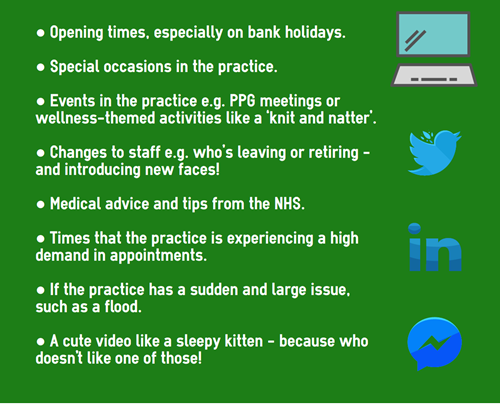
Social media is a great platform for GP practices to stay in contact with patients, invite feedback and connect with the local community. Here are FPM's top tips for getting involved and making the most of your social media presence.
There are many positive aspects to social media, but it's also been controversial because it gives people a platform to send harmful and malicious messages. However, when utilised carefully and correctly, it can mean big results for your GP surgery in terms of communication, promotion and community.
Setting boundaries for online activity
To avoid any HR horror stories associated with using social media in a professional environment, there are a few clear guidelines to follow. Maintaining clear boundaries, having set rules and distinctly outlining the practice’s code of conduct when it comes to social media is vital. Before dipping a toe in the World Wide Web, make sure you have these rules clearly in place!
Once you have these guidelines set out in stone, you need to be confident that you or members of the practice team will have the time to nurture the practice’s social presence. Maintaining a social media presence is a great marketing tool and can provide positive exposure for your practice, but not keeping it up to date can be just as bad as not having one at all.
If you’re moving into social media for the first time, or just giving your strategy a refresh, you need to pick your platform.
We recommend sticking with one or two of the big three:
Facebook: This allows you more characters when posting messages and has more features than Twitter. Facebook requires a small amount of effort to maintain an online presence.
Twitter: Has a smaller character limit but delivers more penetration than Facebook – around 6,000 tweets are sent every second.
LinkedIn: The most business-orientated of the platforms, however it also has the least number of users.
Pick the ones that are most suitable for your practice. Once you’ve picked your platforms, set up an account. Although you can have multiple users on a business account, one person will need to be nominated as the main contact.
Clearly instruct any other team members who will be posting on the site of the rules in place. A golden rule to stick to is – if you’re unsure if something is unsuitable/appropriate/unsafe, don’t post it!
You will need to select a profile picture and usually a cover image too. This is the first aspect to be careful with - if the practice has any official photos or a logo etc. just stick with that. If not, use something appropriate and relevant such as a picture of the practice itself.
If you want to use a picture of the staff, you need to ensure everyone in the photo is happy for it to be used and that this doesn’t go against any protocols in place. This also goes for any future posts featuring photos - ensure everyone in the photograph is happy for it to be shared and no boundaries have been compromised by the context of the photo.
It's time to get posting!
Keep it relevant, frequent and fun! Good things to post about include:

Like any method of communication, there is a risk of receiving a complaint through social media. The best course of action is to ensure the practice has a clear complaints procedure in place that also applies to those received through social media.
Two final tips
- Only be active on the site during practice hours so everyone knows if they leave a comment or message it will be responded due during those times.
- Remember to be clear that the platform won’t be providing an appointment or prescription service - but you can signpost users to your practice website for the information.
Don’t forget you can find First Practice Management on Twitter, LinkedIn and Facebook. Plus, FPM members can access more information about social networking policies in FPM Core.


0 Comments